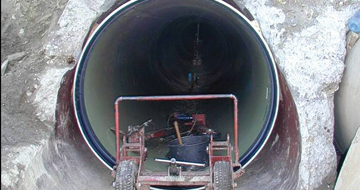
Rehabilitation with HOBAS Pipes in Germany
The need to rehabilitate old sewers poses a big challenge to all cities and urban wastewater associations. Many sewer channels were built of bricks, stoneware, concrete or reinforced concrete. As the years pass, even the highest quality channels show signs of material fatigue and groundwater infiltrations – a development resulting in increasing maintenance costs. Leaking sewer lines also pose a threat to the environment in that the leaking substances can pollute the soil and groundwater. If renovation measures are not implemented in time, the penetration of external water into the sewer systems causes the wastewater treatment plants’ operating costs to rise, and consequent soil washouts and subsidences endanger buildings. Over the past two years, an aged sewer channel in Cologne in Germany required urgent attention: Corrosion, leakages, and a reduced load capacity made their renovation inevitable.
Rehabilition instead of replacement in Cologne
In the course of a routine check of the sewer system, the sewage board in Cologne found a combined sewer DN 1500 in the urban district Sürth to be severely damaged: The concrete pipes showed numerous longitudinal cracks, which affected the 80 m long channel’s structural capability. Above all, a leakage of the combined sewage could not be ruled out, and this was a serious problem since the district is located in a water protection area close to the river Rhine. The decision to rehabilitate the affected section with HOBAS Relining Pipes was linked to technical and economic interests.
The specific mirror-like inner surface of HOBAS GRP Pipes made a reduction in the cross section possible. Three meter long circular HOBAS Pipes De 1280 were supplied, and starting and receiving pits of 5 x 4 m each excavated for their installation. By means of a winch, the pipes were drawn inside the old structure and jointed. The remaining annular space between the old and new pipeline was filled with a pressure-resistant material, and a sand coating of the pipes’ outer surface ensured a particularly good bonding of the grouting. This way, the inserted pipe was fixed in its position and took over the entire load-bearing capacity. Given its walkability, the channel needed to come with ideal anti-slip safety properties, which is why the bottom of the pipe has also been coated with sand.
Thanks to the perfect collaboration of all parties involved and a trouble-free construction process, the rehabilitation works could be successfully completed according to schedule within 50 working days only. The renovated pipeline can compete with a newly-built pipeline in every respect, and the client need not worry about the next quality inspection.
More information about this application
PROJECT DETAILS
| Project ID: [6510] | |
| Country: | Germany |
| City: | Cologne |
| Year: | 2013 |
| Application: | Sewer |
| Installation: | Relining |
| Technology: | Hobas |
| Total Length: | 80 m |
| Nominal Diameter DN: | 1280 mm |
| Nominal Pressure PN: | 1 bar |
